Deck 19: Consumer Choice Appendix: Indifference Curves
Question
Question
Question
Question
Question
Question
Question
Question
Question
Question
Question
Question
Question
Question
Question
Question
Question
Question
Question
Question
Question
Question
Question
Question
Question
Question
Question
Question
Question
Question
Question
Question
Question
Question
Question
Question
Question
Question
Question
Question
Question
Question
Question
Question
Question
Question
Question
Question
Question
Question
Question
Question
Question
Question
Question
Question
Question
Question
Question
Question
Question
Question
Question
Question
Question
Question
Question
Question
Question
Question
Question
Question
Question
Question
Question
Question
Question
Question
Question
Question

Unlock Deck
Sign up to unlock the cards in this deck!
Unlock Deck
Unlock Deck
1/117
Play
Full screen (f)
Deck 19: Consumer Choice Appendix: Indifference Curves
1
If an individual demands a good,it means that he or she
A)Has a strong desire for the good.
B)Is willing and able to purchase the good at some price.
C)Must need the good.
A)Has a strong desire for the good.
B)Is willing and able to purchase the good at some price.
C)Must need the good.
Is willing and able to purchase the good at some price.
2
The law of diminishing marginal utility states that
A)The total utility of consuming the next unit of a good falls.
B)As a consumer enjoys successive units of a good,eventually marginal utility will fall.
C)Marginal utility always falls to zero after two or three units of a good consumed.
A)The total utility of consuming the next unit of a good falls.
B)As a consumer enjoys successive units of a good,eventually marginal utility will fall.
C)Marginal utility always falls to zero after two or three units of a good consumed.
As a consumer enjoys successive units of a good,eventually marginal utility will fall.
3
Total utility is maximized when
A)Price is less than marginal utility.
B)Price is equal to marginal utility.
C)Marginal utility is zero.
A)Price is less than marginal utility.
B)Price is equal to marginal utility.
C)Marginal utility is zero.
Marginal utility is zero.
4
Utility refers to the
A)Satisfaction obtained from a good or service.
B)Additional satisfaction obtained from one more unit of a good or service.
C)Willingness to buy specific quantities of a good or service at a particular price.
A)Satisfaction obtained from a good or service.
B)Additional satisfaction obtained from one more unit of a good or service.
C)Willingness to buy specific quantities of a good or service at a particular price.

Unlock Deck
Unlock for access to all 117 flashcards in this deck.
Unlock Deck
k this deck
5
Economists accept consumer tastes as given and focus on
A)How price will affect actual consumer purchases.
B)How culture affects consumer preferences.
C)How advertising molds consumer desires.
A)How price will affect actual consumer purchases.
B)How culture affects consumer preferences.
C)How advertising molds consumer desires.

Unlock Deck
Unlock for access to all 117 flashcards in this deck.
Unlock Deck
k this deck
6
Total utility is
A)The additional utility from consuming one more unit of a good.
B)The sum of the marginal utilities from the consumption of good.
C)A function that always falls as a buyer enjoys more units of a good.
A)The additional utility from consuming one more unit of a good.
B)The sum of the marginal utilities from the consumption of good.
C)A function that always falls as a buyer enjoys more units of a good.

Unlock Deck
Unlock for access to all 117 flashcards in this deck.
Unlock Deck
k this deck
7
When economists refer to the determinants of demand,they are referring to factors that
A)Cause a movement down a demand curve.
B)Cause the demand curve to shift left or right.
C)Influence producer behavior.
A)Cause a movement down a demand curve.
B)Cause the demand curve to shift left or right.
C)Influence producer behavior.

Unlock Deck
Unlock for access to all 117 flashcards in this deck.
Unlock Deck
k this deck
8
The additional pleasure or satisfaction from a good declines as more of it is consumed in a given period.This is the definition of the
A)Law of demand.
B)Law of diminishing marginal utility.
C)Law of diminishing total utility.
A)Law of demand.
B)Law of diminishing marginal utility.
C)Law of diminishing total utility.

Unlock Deck
Unlock for access to all 117 flashcards in this deck.
Unlock Deck
k this deck
9
As more satisfaction is achieved from consuming a good with diminishing marginal utility,then total utility
A)Increases at a decreasing rate.
B)Decreases as long as marginal utility is negative.
C)Decreases as long as marginal utility is positive.
A)Increases at a decreasing rate.
B)Decreases as long as marginal utility is negative.
C)Decreases as long as marginal utility is positive.

Unlock Deck
Unlock for access to all 117 flashcards in this deck.
Unlock Deck
k this deck
10
The law of diminishing marginal utility suggests that
A)People are willing to buy additional quantities of a good only if its price falls.
B)People will substitute lower-priced goods for more expensive goods,ceteris paribus.
C)Price and quantity demanded are directly related.
A)People are willing to buy additional quantities of a good only if its price falls.
B)People will substitute lower-priced goods for more expensive goods,ceteris paribus.
C)Price and quantity demanded are directly related.

Unlock Deck
Unlock for access to all 117 flashcards in this deck.
Unlock Deck
k this deck
11
If a product has a high marginal utility,then
A)Consumers will not purchase any more of the good.
B)The demand curve will be downward-sloping.
C)A consumer is willing to pay a high price for it.
A)Consumers will not purchase any more of the good.
B)The demand curve will be downward-sloping.
C)A consumer is willing to pay a high price for it.

Unlock Deck
Unlock for access to all 117 flashcards in this deck.
Unlock Deck
k this deck
12
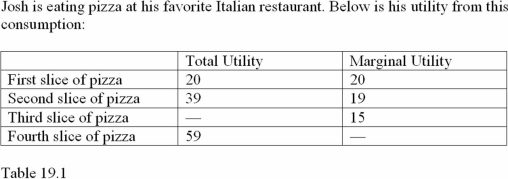
Refer to Table 19.1.For Josh,diminishing marginal utility begins
A)After the first slice of pizza.
B)After the third slice of pizza.
C)After the second slice of pizza.

Unlock Deck
Unlock for access to all 117 flashcards in this deck.
Unlock Deck
k this deck
13
If marginal utility is negative,then
A)Total utility will increase with additional consumption.
B)Total utility will decrease with additional consumption.
C)The good or service being consumed is an inferior good.
A)Total utility will increase with additional consumption.
B)Total utility will decrease with additional consumption.
C)The good or service being consumed is an inferior good.

Unlock Deck
Unlock for access to all 117 flashcards in this deck.
Unlock Deck
k this deck
14
Jose goes to an all-you-can-eat buffet at a Chinese restaurant and consumes three plates of food.He does not go back for a fourth plate of food because
A)The price of the fourth plate is too high.
B)He has reached the point of increasing marginal utility.
C)The marginal utility of the fourth plate would be zero or even negative.
A)The price of the fourth plate is too high.
B)He has reached the point of increasing marginal utility.
C)The marginal utility of the fourth plate would be zero or even negative.

Unlock Deck
Unlock for access to all 117 flashcards in this deck.
Unlock Deck
k this deck
15
Sociopsychiatric explanations of consumer behavior include the
A)Desire for ego and status.
B)Level of income.
C)Level of wealth.
A)Desire for ego and status.
B)Level of income.
C)Level of wealth.

Unlock Deck
Unlock for access to all 117 flashcards in this deck.
Unlock Deck
k this deck
16

Refer to Table 19.1.What is Josh's total utility from consuming the third slice of pizza?
A)20 utils.
B)54 utils.
C)5 utils.

Unlock Deck
Unlock for access to all 117 flashcards in this deck.
Unlock Deck
k this deck
17

Refer to Table 19.1.The marginal utility Josh enjoys from the fourth slice of pizza is
A)20 utils.
B)54 utils.
C)5 utils.

Unlock Deck
Unlock for access to all 117 flashcards in this deck.
Unlock Deck
k this deck
18
Which of the following is not a determinant of demand?
A)Desire for the good.
B)Income of the consumer.
C)The cost of the factor inputs.
A)Desire for the good.
B)Income of the consumer.
C)The cost of the factor inputs.

Unlock Deck
Unlock for access to all 117 flashcards in this deck.
Unlock Deck
k this deck
19
Marginal utility is
A)The sum of the total utility of consuming a certain amount of a good.
B)The additional utility a consumer enjoys from the consumption of one more unit of a good.
C)The diminishing nature of total utility.
A)The sum of the total utility of consuming a certain amount of a good.
B)The additional utility a consumer enjoys from the consumption of one more unit of a good.
C)The diminishing nature of total utility.

Unlock Deck
Unlock for access to all 117 flashcards in this deck.
Unlock Deck
k this deck
20
Graphically,as a consumer buys more of a good,the marginal utility line will
A)Increase as more goods are consumed.
B)Increase steadily and then decline.
C)Continuously decline if diminishing returns are present.
A)Increase as more goods are consumed.
B)Increase steadily and then decline.
C)Continuously decline if diminishing returns are present.

Unlock Deck
Unlock for access to all 117 flashcards in this deck.
Unlock Deck
k this deck
21
The ___________ surplus will rise if the price of the good ________.
A)consumer;rises
B)consumer;falls
C)producer;falls
A)consumer;rises
B)consumer;falls
C)producer;falls

Unlock Deck
Unlock for access to all 117 flashcards in this deck.
Unlock Deck
k this deck
22
If the equilibrium price rises,
A)The consumer surplus will be reduced.
B)The producer surplus will fall.
C)The consumer surplus will increase.
A)The consumer surplus will be reduced.
B)The producer surplus will fall.
C)The consumer surplus will increase.

Unlock Deck
Unlock for access to all 117 flashcards in this deck.
Unlock Deck
k this deck
23
The total consumer surplus is shown on a graph as
A)The area under the demand curve and below the actual price.
B)The area under the demand curve and above the actual price.
C)The area above the demand curve and above the actual price.
A)The area under the demand curve and below the actual price.
B)The area under the demand curve and above the actual price.
C)The area above the demand curve and above the actual price.

Unlock Deck
Unlock for access to all 117 flashcards in this deck.
Unlock Deck
k this deck
24
The law of diminishing marginal utility gives us a deeper understanding of the downward-sloping demand curve because
A)Consumers are willing to pay a higher price for a greater quantity.
B)Consumer tastes change due to advertising.
C)When marginal utility is high,we are willing to pay a higher price.
A)Consumers are willing to pay a higher price for a greater quantity.
B)Consumer tastes change due to advertising.
C)When marginal utility is high,we are willing to pay a higher price.

Unlock Deck
Unlock for access to all 117 flashcards in this deck.
Unlock Deck
k this deck
25
Sellers can gain profits from price discrimination because
A)Charging different prices based on willingness to pay can increase revenues.
B)Total expenses are less with price discrimination.
C)Total revenues are maximized when all buyers pay the same price.
A)Charging different prices based on willingness to pay can increase revenues.
B)Total expenses are less with price discrimination.
C)Total revenues are maximized when all buyers pay the same price.

Unlock Deck
Unlock for access to all 117 flashcards in this deck.
Unlock Deck
k this deck
26
According to the law of demand,ceteris paribus,
A)The quantity demanded increases at lower prices.
B)A consumer will purchase more of a good at higher prices than at lower prices.
C)Price and quantity supplied are directly related.
A)The quantity demanded increases at lower prices.
B)A consumer will purchase more of a good at higher prices than at lower prices.
C)Price and quantity supplied are directly related.

Unlock Deck
Unlock for access to all 117 flashcards in this deck.
Unlock Deck
k this deck
27
Car dealers can easily price discriminate because
A)Buyers do not know the car's price.
B)Sellers negotiate a separate price agreement with each individual buyer.
C)Each seller knows the price but the buyer does not.
A)Buyers do not know the car's price.
B)Sellers negotiate a separate price agreement with each individual buyer.
C)Each seller knows the price but the buyer does not.

Unlock Deck
Unlock for access to all 117 flashcards in this deck.
Unlock Deck
k this deck
28
Which of the following statements best captures the concept of consumer surplus?
A)"I saw a sale for flowers,so I bought four bundles."
B)"I was willing to pay $30 for a dozen roses,but I bought them for $20."
C)"I was willing to pay $30 for roses,but they are selling for $35,so I did not buy."
A)"I saw a sale for flowers,so I bought four bundles."
B)"I was willing to pay $30 for a dozen roses,but I bought them for $20."
C)"I was willing to pay $30 for roses,but they are selling for $35,so I did not buy."

Unlock Deck
Unlock for access to all 117 flashcards in this deck.
Unlock Deck
k this deck
29
Consumer surplus measures
A)The difference between the maximum price a consumer is willing to pay and the price actually paid.
B)The difference between the minimum price a consumer is willing to pay and the price actually paid.
C)The difference between the amounts of a good a consumer is willing to pay,and how much of the good is available for sale.
A)The difference between the maximum price a consumer is willing to pay and the price actually paid.
B)The difference between the minimum price a consumer is willing to pay and the price actually paid.
C)The difference between the amounts of a good a consumer is willing to pay,and how much of the good is available for sale.

Unlock Deck
Unlock for access to all 117 flashcards in this deck.
Unlock Deck
k this deck
30
Which of these examples is an example of price discrimination?
A)Goods are marked down on sale.
B)Wholesale prices differ from retail prices.
C)Seniors pay one price at the movie theater and adults pay more.
A)Goods are marked down on sale.
B)Wholesale prices differ from retail prices.
C)Seniors pay one price at the movie theater and adults pay more.

Unlock Deck
Unlock for access to all 117 flashcards in this deck.
Unlock Deck
k this deck
31
The benefit that consumers get when they buy goods at the equilibrium price is called
A)Marginal utility.
B)The law of demand.
C)Consumer surplus.
A)Marginal utility.
B)The law of demand.
C)Consumer surplus.

Unlock Deck
Unlock for access to all 117 flashcards in this deck.
Unlock Deck
k this deck
32
Which of the following is not held constant when considering a shift in the demand for pizza?
A)Consumer incomes.
B)The price of pizza.
C)The price of spaghetti (a substitute).
A)Consumer incomes.
B)The price of pizza.
C)The price of spaghetti (a substitute).

Unlock Deck
Unlock for access to all 117 flashcards in this deck.
Unlock Deck
k this deck
33
Most goods can yield
A)Only positive marginal utility.
B)Both positive and negative marginal utility.
C)Only negative marginal utility.
A)Only positive marginal utility.
B)Both positive and negative marginal utility.
C)Only negative marginal utility.

Unlock Deck
Unlock for access to all 117 flashcards in this deck.
Unlock Deck
k this deck
34
Price discrimination is ________ in the United States and ________ practiced.
A)legal;rarely
B)illegal;widely
C)legal;often
A)legal;rarely
B)illegal;widely
C)legal;often

Unlock Deck
Unlock for access to all 117 flashcards in this deck.
Unlock Deck
k this deck
35
When sellers price discriminate,
A)They are attempting to charge a price that is the maximum price each individual is willing to pay.
B)They are trying to pit one group of buyers against another.
C)They are trying to find a minimum price the individual is willing to pay.
A)They are attempting to charge a price that is the maximum price each individual is willing to pay.
B)They are trying to pit one group of buyers against another.
C)They are trying to find a minimum price the individual is willing to pay.

Unlock Deck
Unlock for access to all 117 flashcards in this deck.
Unlock Deck
k this deck
36
Rosa is willing to pay $200 for the iPhone,but the actual price is $400.This means
A)Rosa will enjoy a consumer surplus of $200 if she buys the iPhone.
B)Rosa will not enjoy any consumer surplus from purchasing the iPhone.
C)Rosa will buy this product.
A)Rosa will enjoy a consumer surplus of $200 if she buys the iPhone.
B)Rosa will not enjoy any consumer surplus from purchasing the iPhone.
C)Rosa will buy this product.

Unlock Deck
Unlock for access to all 117 flashcards in this deck.
Unlock Deck
k this deck
37
 Refer to Figure 19.1.The total consumer surplus in this market is equal to
Refer to Figure 19.1.The total consumer surplus in this market is equal toA)$950.
B)$900.
C)$850.

Unlock Deck
Unlock for access to all 117 flashcards in this deck.
Unlock Deck
k this deck
38
The _________ of the demand curve corresponds to the idea that the marginal utility for the first few goods is _____________________.
A)top;lower
B)bottom;lower
C)top;higher
A)top;lower
B)bottom;lower
C)top;higher

Unlock Deck
Unlock for access to all 117 flashcards in this deck.
Unlock Deck
k this deck
39
The four determinants of demand that are held constant when we consider a movement along a demand curve include all of the following except
A)Price.
B)Income.
C)Tastes.
A)Price.
B)Income.
C)Tastes.

Unlock Deck
Unlock for access to all 117 flashcards in this deck.
Unlock Deck
k this deck
40
Price discrimination occurs when
A)Minorities pay a higher price for a product than everyone else.
B)Sellers charge a higher price than is reasonable.
C)Sellers charge two separate prices for the same product to two different groups.
A)Minorities pay a higher price for a product than everyone else.
B)Sellers charge a higher price than is reasonable.
C)Sellers charge two separate prices for the same product to two different groups.

Unlock Deck
Unlock for access to all 117 flashcards in this deck.
Unlock Deck
k this deck
41
When choosing among products,consumers look at
A)The marginal utility per dollar and their budget constraint.
B)The total utility that will be gained at the end of all consumption.
C)Only their budget.
A)The marginal utility per dollar and their budget constraint.
B)The total utility that will be gained at the end of all consumption.
C)Only their budget.

Unlock Deck
Unlock for access to all 117 flashcards in this deck.
Unlock Deck
k this deck
42
Price discrimination
A)Is illegal.
B)Rarely occurs in the airline industry.
C)Is a way for sellers to exact the maximum willingness to pay from buyers.
A)Is illegal.
B)Rarely occurs in the airline industry.
C)Is a way for sellers to exact the maximum willingness to pay from buyers.

Unlock Deck
Unlock for access to all 117 flashcards in this deck.
Unlock Deck
k this deck
43
A successful advertising campaign will
A)Increase the demand for the advertised good.
B)Increase the price elasticity of demand for the advertised good.
C)Cause the quantity supplied of the advertised good to increase.
A)Increase the demand for the advertised good.
B)Increase the price elasticity of demand for the advertised good.
C)Cause the quantity supplied of the advertised good to increase.

Unlock Deck
Unlock for access to all 117 flashcards in this deck.
Unlock Deck
k this deck
44
Airline companies engage in price discrimination by
A)Charging unrestricted fares.
B)Giving a temporary price cut.
C)Charging business customers higher prices than vacation travelers.
A)Charging unrestricted fares.
B)Giving a temporary price cut.
C)Charging business customers higher prices than vacation travelers.

Unlock Deck
Unlock for access to all 117 flashcards in this deck.
Unlock Deck
k this deck
45
If a successful advertising campaign increases brand loyalty,the
A)Supply of the advertised good will become less elastic.
B)Demand for the advertised good will become less elastic.
C)Supply of substitutes for the advertised good will increase.
A)Supply of the advertised good will become less elastic.
B)Demand for the advertised good will become less elastic.
C)Supply of substitutes for the advertised good will increase.

Unlock Deck
Unlock for access to all 117 flashcards in this deck.
Unlock Deck
k this deck
46
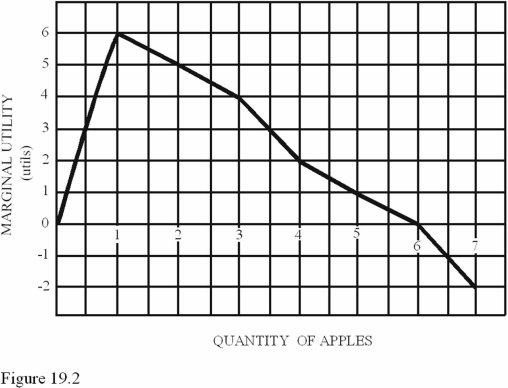
Refer to Figure 19.2.With no budget constraint,a rational consumer will consume _________ apple(s).
A)zero
B)one
C)six

Unlock Deck
Unlock for access to all 117 flashcards in this deck.
Unlock Deck
k this deck
47
Maximum utility is achieved when
A)Total revenue is the greatest.
B)The price elasticity of demand is 1.0.
C)Marginal utility is zero.
A)Total revenue is the greatest.
B)The price elasticity of demand is 1.0.
C)Marginal utility is zero.

Unlock Deck
Unlock for access to all 117 flashcards in this deck.
Unlock Deck
k this deck
48
Which industry here is unlikely to exhibit price discrimination?
A)Airlines.
B)New cars.
C)Supermarkets.
A)Airlines.
B)New cars.
C)Supermarkets.

Unlock Deck
Unlock for access to all 117 flashcards in this deck.
Unlock Deck
k this deck
49
If advertising is successful,
A)The demand becomes more elastic.
B)The demand curve shifts to the left.
C)The demand curve shifts to the right and becomes steeper.
A)The demand becomes more elastic.
B)The demand curve shifts to the left.
C)The demand curve shifts to the right and becomes steeper.

Unlock Deck
Unlock for access to all 117 flashcards in this deck.
Unlock Deck
k this deck
50
Assume Amanda always maximizes her total utility given her budget constraint.Every morning for breakfast she has two eggs and three sausages.If the marginal utility of the last egg is 10 utils and the price of eggs is $1 each,what can we say about the marginal utility of the last sausage if the price of each sausage is $2?
A)It must be equal to 20 utils.
B)It must be equal to 10 utils.
C)It must be equal to 5 utils.
A)It must be equal to 20 utils.
B)It must be equal to 10 utils.
C)It must be equal to 5 utils.

Unlock Deck
Unlock for access to all 117 flashcards in this deck.
Unlock Deck
k this deck
51
Marginal utility is the
A)Change in total utility obtained by spending one extra dollar on a good or service.
B)Change in total utility obtained by consuming one extra unit of a good or service.
C)Change in total utility obtained by selling one extra unit of a good or service.
A)Change in total utility obtained by spending one extra dollar on a good or service.
B)Change in total utility obtained by consuming one extra unit of a good or service.
C)Change in total utility obtained by selling one extra unit of a good or service.

Unlock Deck
Unlock for access to all 117 flashcards in this deck.
Unlock Deck
k this deck
52
In the article "Men vs.Women: How They Spend,"
A)Both sexes spend more than they earn.
B)Both sexes make the same annual income.
C)Both sexes spend the same amount of money on clothing purchases.
A)Both sexes spend more than they earn.
B)Both sexes make the same annual income.
C)Both sexes spend the same amount of money on clothing purchases.

Unlock Deck
Unlock for access to all 117 flashcards in this deck.
Unlock Deck
k this deck
53
Price discrimination works best when
A)Sellers cannot meet collectively.
B)Buyers do not have perfect information about the price.
C)Buyers have information about prices charged to different customers.
A)Sellers cannot meet collectively.
B)Buyers do not have perfect information about the price.
C)Buyers have information about prices charged to different customers.

Unlock Deck
Unlock for access to all 117 flashcards in this deck.
Unlock Deck
k this deck
54
The In the News article titled "Men vs.Women: How They Spend" differentiates the spending habits of women and men: "Men spend almost twice as much as women do on electronic equipment … young women spend twice as much money on clothing,personal care items,and their pets." Which determinant of demand is most likely involved?
A)Income.
B)Tastes.
C)Expectations.
A)Income.
B)Tastes.
C)Expectations.

Unlock Deck
Unlock for access to all 117 flashcards in this deck.
Unlock Deck
k this deck
55
Suppose Caesar allocates his entire budget to the purchase of soft drinks and chips.The marginal utility of the last bottle of soft drink purchased is 12 utils,and each bottle costs $1.20.The marginal utility of the last bag of chips purchased is 8 utils,and each bag costs $1.In order to maximize his utility,Caesar should
A)Buy more soft drinks and fewer chips since he gets more marginal utility per dollar from soft drinks.
B)Buy more chips and fewer soft drinks because of the lower price for chips.
C)Buy more soft drinks and fewer chips because the soft drink has fewer calories.
A)Buy more soft drinks and fewer chips since he gets more marginal utility per dollar from soft drinks.
B)Buy more chips and fewer soft drinks because of the lower price for chips.
C)Buy more soft drinks and fewer chips because the soft drink has fewer calories.

Unlock Deck
Unlock for access to all 117 flashcards in this deck.
Unlock Deck
k this deck
56
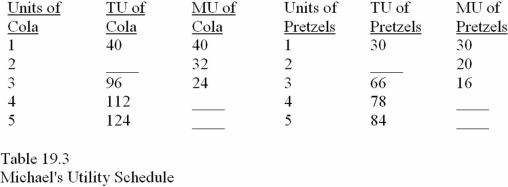
Complete Table 19.3.Assume the price of cola is $8 per unit and the price of pretzels is $4 per unit. Refer to Table 19.3.If Michael has $48 to spend on cola and pretzels,what combination should he purchase in order to maximize his utility?
A)Four colas and four pretzels.
B)Five colas and two pretzels.
C)Three colas and five pretzels.

Unlock Deck
Unlock for access to all 117 flashcards in this deck.
Unlock Deck
k this deck
57
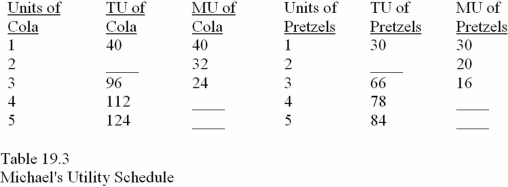
Complete Table 19.3 .Assume the price of cola is $8 per unit and the price of pretzels is $4 per unit. Refer to Table 19.3.If Michael has $28 dollars to spend,why will three colas and four pretzels not be optimal?
A)This combination has less total utility.
B)This combination is affordable but does not maximize utility.
C)This combination is not affordable.

Unlock Deck
Unlock for access to all 117 flashcards in this deck.
Unlock Deck
k this deck
58

Refer to Figure 19.2.Total utility is maximized at
A)6 apples.
B)7 apples.
C)1 apple.

Unlock Deck
Unlock for access to all 117 flashcards in this deck.
Unlock Deck
k this deck
59
A consumer maximizes total utility from a given amount of income when the
A)Marginal utility obtained from the last dollar spent on each good is the same.
B)Marginal utility of the last unit of each good is the same.
C)Total utility obtained from each product is the same.
A)Marginal utility obtained from the last dollar spent on each good is the same.
B)Marginal utility of the last unit of each good is the same.
C)Total utility obtained from each product is the same.

Unlock Deck
Unlock for access to all 117 flashcards in this deck.
Unlock Deck
k this deck
60
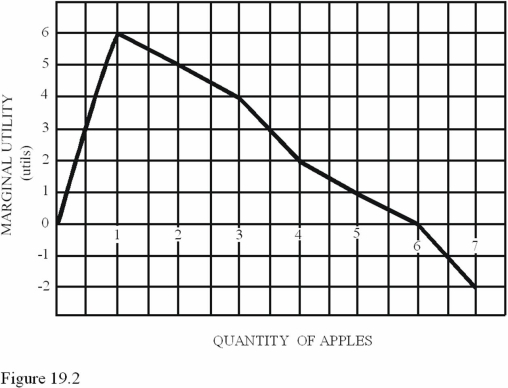
Refer to Figure 19.2.The total utility of five apples is
A)1 utils.
B)17 utils.
C)18 utils.

Unlock Deck
Unlock for access to all 117 flashcards in this deck.
Unlock Deck
k this deck
61
All of the possible combinations of two goods that lie on one indifference curve
A)Give the consumer the highest possible utility.
B)Yield the same level of utility.
C)Are affordable.
A)Give the consumer the highest possible utility.
B)Yield the same level of utility.
C)Are affordable.

Unlock Deck
Unlock for access to all 117 flashcards in this deck.
Unlock Deck
k this deck
62
The mix of consumer purchases that maximizes the utility attainable from available income is called the
A)Total utility combination.
B)Marginal utility combination.
C)Optimal consumption.
A)Total utility combination.
B)Marginal utility combination.
C)Optimal consumption.

Unlock Deck
Unlock for access to all 117 flashcards in this deck.
Unlock Deck
k this deck
63
Economists focus on the effect of changes in income and prices in influencing actual consumer purchases.

Unlock Deck
Unlock for access to all 117 flashcards in this deck.
Unlock Deck
k this deck
64
Any point on the budget constraint
A)Gives the consumer the highest level of utility.
B)Represent a combination of two goods that are affordable.
C)Represents combinations of two goods that yield the same utility.
A)Gives the consumer the highest level of utility.
B)Represent a combination of two goods that are affordable.
C)Represents combinations of two goods that yield the same utility.

Unlock Deck
Unlock for access to all 117 flashcards in this deck.
Unlock Deck
k this deck
65
An indifference curve shows the
A)Maximum utility that can be achieved for a given consumer budget.
B)Maximum utility that can be achieved for different amounts of a good.
C)Combinations of goods giving equal utility to a consumer.
A)Maximum utility that can be achieved for a given consumer budget.
B)Maximum utility that can be achieved for different amounts of a good.
C)Combinations of goods giving equal utility to a consumer.

Unlock Deck
Unlock for access to all 117 flashcards in this deck.
Unlock Deck
k this deck
66
Marginal utility represents the additional satisfaction obtained from one more unit of a good or service.

Unlock Deck
Unlock for access to all 117 flashcards in this deck.
Unlock Deck
k this deck
67
The point where the budget constraint and an indifference curve are tangent
A)Represents maximum total revenue.
B)Indicates the optimal level of production.
C)Represents the optimal consumption point.
A)Represents maximum total revenue.
B)Indicates the optimal level of production.
C)Represents the optimal consumption point.

Unlock Deck
Unlock for access to all 117 flashcards in this deck.
Unlock Deck
k this deck
68
The slope of the indifference curve is equal to the
A)Ratio of the price of one good to the price of the other good.
B)Income of the consumer.
C)Marginal rate of substitution.
A)Ratio of the price of one good to the price of the other good.
B)Income of the consumer.
C)Marginal rate of substitution.

Unlock Deck
Unlock for access to all 117 flashcards in this deck.
Unlock Deck
k this deck
69
If Josh's income increases,then
A)His entire budget constraint will shift toward the origin.
B)His entire budget constraint will shift away from the origin.
C)His indifference curves will shift away from the origin.
A)His entire budget constraint will shift toward the origin.
B)His entire budget constraint will shift away from the origin.
C)His indifference curves will shift away from the origin.

Unlock Deck
Unlock for access to all 117 flashcards in this deck.
Unlock Deck
k this deck
70
Status and ego considerations in consumption are economic explanations of demand.

Unlock Deck
Unlock for access to all 117 flashcards in this deck.
Unlock Deck
k this deck
71
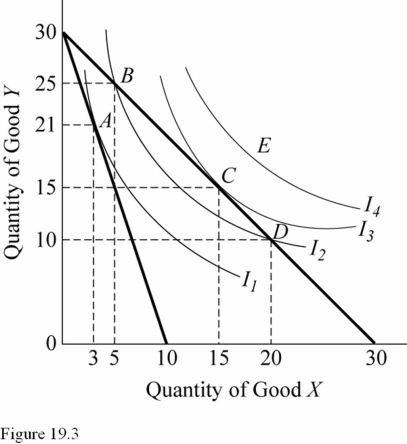
Use the indifference curves and the budget lines in Figure 19.3 to answer the indicated question.Assume the price of Y is $1 per unit.If the price per unit of good X is $3,the consumer would maximize utility by consuming
A)30 units of Y.
B)21 units of Y.
C)10 units of Y.

Unlock Deck
Unlock for access to all 117 flashcards in this deck.
Unlock Deck
k this deck
72
The law of diminishing marginal utility does not apply to goods that a person really enjoys.

Unlock Deck
Unlock for access to all 117 flashcards in this deck.
Unlock Deck
k this deck
73
Psychology and sociology focus on what creates desires for goods,but economics focuses on what consumers actually purchase.

Unlock Deck
Unlock for access to all 117 flashcards in this deck.
Unlock Deck
k this deck
74
The slope of the budget constraint,when a consumer has reached optimal consumption of two goods,is equal to the
A)Marginal rate of substitution.
B)Cross-price elasticity of the two goods.
C)Total utility for the two goods.
A)Marginal rate of substitution.
B)Cross-price elasticity of the two goods.
C)Total utility for the two goods.

Unlock Deck
Unlock for access to all 117 flashcards in this deck.
Unlock Deck
k this deck
75

Use the indifference curves and the budget lines in Figure 19.3 to answer the indicated question.Assume the price of Y is $1 per unit.In Figure 19.3,point E
A)Is optimal and affordable.
B)Gives the consumer a very high level of utility and is affordable.
C)Is a very high level of utility but not affordable.

Unlock Deck
Unlock for access to all 117 flashcards in this deck.
Unlock Deck
k this deck
76

Use the indifference curves and the budget lines in Figure 19.3 to answer the indicated question.Assume the price of Y is $1 per unit.In Figure 19.3,given an income of $30 and a price for good Y of $1,which of the following two points represent optimal consumption?
A)A when the price of X is $3 and C when the price of X is $1.
B)B when the price of X is $1 and D when the price of X is $3.
C)A when the price of X is $1 and D when the price of X is $3.

Unlock Deck
Unlock for access to all 117 flashcards in this deck.
Unlock Deck
k this deck
77

Use the indifference curves and the budget lines in Figure 19.3 to answer the indicated question.Assume the price of Y is $1 per unit.If the price per unit of good X is $1,the consumer would maximize utility by consuming
A)25 units of Y.
B)21 units of Y.
C)15 units of Y.

Unlock Deck
Unlock for access to all 117 flashcards in this deck.
Unlock Deck
k this deck
78
An indifference map shows
A)A set of indifference curves.
B)One indifference curve.
C)A set of indifference curves and a set of budget constraints.
A)A set of indifference curves.
B)One indifference curve.
C)A set of indifference curves and a set of budget constraints.

Unlock Deck
Unlock for access to all 117 flashcards in this deck.
Unlock Deck
k this deck
79
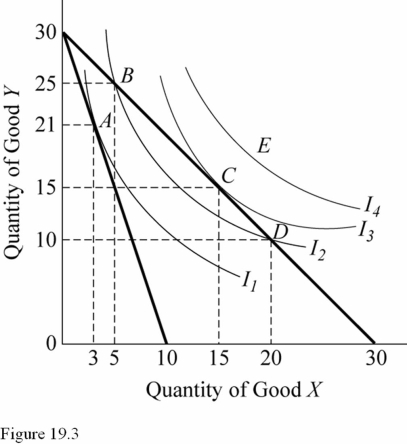
Use the indifference curves and the budget lines in Figure 19.3 to answer the indicated question.Assume the price of Y is $1 per unit.Point D on the graph
A)Is not affordable.
B)Is affordable but does not yield the highest utility possible.
C)Is affordable and is the optimal consumption bundle for this individual.

Unlock Deck
Unlock for access to all 117 flashcards in this deck.
Unlock Deck
k this deck
80
Assume that Anna buys peanut butter and bread.If the price of peanut butter falls,then
A)One end of her budget constraint will move away from the origin.
B)Her entire budget constraint will shift toward the origin.
C)Her entire budget constraint will shift away from the origin.
A)One end of her budget constraint will move away from the origin.
B)Her entire budget constraint will shift toward the origin.
C)Her entire budget constraint will shift away from the origin.

Unlock Deck
Unlock for access to all 117 flashcards in this deck.
Unlock Deck
k this deck



